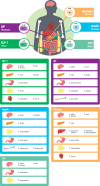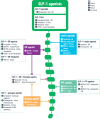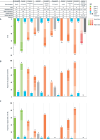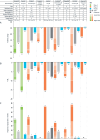What is the pipeline for future medications for obesity?
- PMID: 38302593
- PMCID: PMC11971045
- DOI: 10.1038/s41366-024-01473-y
What is the pipeline for future medications for obesity?
Abstract
Obesity is a chronic disease associated with increased risk of obesity-related complications and mortality. Our better understanding of the weight regulation mechanisms and the role of gut-brain axis on appetite has led to the development of safe and effective entero-pancreatic hormone-based treatments for obesity such as glucagon-like peptide-1 (GLP-1) receptor agonists (RA). Semaglutide 2.4 mg once weekly, a subcutaneously administered GLP-1 RA approved for obesity treatment in 2021, results in 15-17% mean weight loss (WL) with evidence of cardioprotection. Oral GLP-1 RA are also under development and early data shows similar WL efficacy to semaglutide 2.4 mg. Looking to the next generation of obesity treatments, combinations of GLP-1 with other entero-pancreatic hormones with complementary actions and/or synergistic potential (such as glucose-dependent insulinotropic polypeptide (GIP), glucagon, and amylin) are under investigation to enhance the WL and cardiometabolic benefits of GLP-1 RA. Tirzepatide, a dual GLP-1/GIP receptor agonist has been approved for glycaemic control in type 2 diabetes as well as for obesity management leading in up to 22.5% WL in phase 3 obesity trials. Other combinations of entero-pancreatic hormones including cagrisema (GLP-1/amylin RA) and the triple agonist retatrutide (GLP-1/GIP/glucagon RA) have also progressed to phase 3 trials as obesity treatments and early data suggests that may lead to even greater WL than tirzepatide. Additionally, agents with different mechanisms of action to entero-pancreatic hormones (e.g. bimagrumab) may improve the body composition during WL and are in early phase clinical trials. We are in a new era for obesity pharmacotherapy where combinations of entero-pancreatic hormones approach the WL achieved with bariatric surgery. In this review, we present the efficacy and safety data for the pipeline of obesity pharmacotherapies with a focus on entero-pancreatic hormone-based treatments and we consider the clinical implications and challenges that the new era in obesity management may bring.
© 2024. The Author(s).
Conflict of interest statement
Competing interests: E.M. and U.A. declare no competing interest. D.P. has acted as a speaker for Novo Nordisk and has received grants from Novo Nordisk, Novo Nordisk UK Research Foundation, Academy of Medical Sciences/ Diabetes UK and Health Education East Midlands. M.J.D. has acted as consultant, advisory board member and speaker for Boehringer Ingelheim, Eli Lilly, Novo Nordisk and Sanofi, an advisory board member Lexicon, Pfizer, ShouTi Pharma Inc, AstraZeneca and Medtronic and as a speaker for AstraZeneca, Napp Pharmaceuticals, Novartis and Amgen. M.J.D has received grants from AstraZeneca, Novo Nordisk, Boehringer Ingelheim, Janssen and Sanofi-Aventis and Eli Lilly.
Figures




Similar articles
-
Oral glucagon-like peptide-1 receptor agonists and combinations of entero-pancreatic hormones as treatments for adults with type 2 diabetes: where are we now?Expert Opin Pharmacother. 2024 May;25(7):801-818. doi: 10.1080/14656566.2024.2356254. Epub 2024 May 22. Expert Opin Pharmacother. 2024. PMID: 38753454 Free PMC article. Review.
-
Glucagon-like peptide-1 receptor analogues and beyond: emerging obesity pharmacotherapies.Panminerva Med. 2025 Jul 29. doi: 10.23736/S0031-0808.25.05339-X. Online ahead of print. Panminerva Med. 2025. PMID: 40728225
-
The promise of glucagon-like peptide 1 receptor agonists (GLP-1RA) for the treatment of obesity: a look at phase 2 and 3 pipelines.Expert Opin Investig Drugs. 2025 Mar;34(3):197-215. doi: 10.1080/13543784.2025.2472408. Epub 2025 Mar 1. Expert Opin Investig Drugs. 2025. PMID: 40022548 Review.
-
Why does GLP-1 agonist combined with GIP and/or GCG agonist have greater weight loss effect than GLP-1 agonist alone in obese adults without type 2 diabetes?Diabetes Obes Metab. 2025 Mar;27(3):1079-1095. doi: 10.1111/dom.16106. Epub 2024 Nov 26. Diabetes Obes Metab. 2025. PMID: 39592891 Review.
-
Incretin hormone agonists: Current and emerging pharmacotherapy for obesity management.Pharmacotherapy. 2024 Sep;44(9):738-752. doi: 10.1002/phar.4607. Epub 2024 Sep 3. Pharmacotherapy. 2024. PMID: 39225417 Review.
Cited by
-
New Developments in Pharmacological Treatment of Obesity and Type 2 Diabetes-Beyond and within GLP-1 Receptor Agonists.Biomedicines. 2024 Jun 13;12(6):1320. doi: 10.3390/biomedicines12061320. Biomedicines. 2024. PMID: 38927527 Free PMC article. Review.
-
Paradigm shift in obesity treatment: an extensive review of current pipeline agents.Turk J Med Sci. 2025 Jan 15;55(1):1-16. doi: 10.55730/1300-0144.5938. eCollection 2025. Turk J Med Sci. 2025. PMID: 40104296 Free PMC article. Review.
-
Molecular Mechanisms behind Obesity and Their Potential Exploitation in Current and Future Therapy.Int J Mol Sci. 2024 Jul 27;25(15):8202. doi: 10.3390/ijms25158202. Int J Mol Sci. 2024. PMID: 39125772 Free PMC article. Review.
-
Progress in antiobesity medications.Proc (Bayl Univ Med Cent). 2025 Feb 26;38(3):304. doi: 10.1080/08998280.2025.2469990. eCollection 2025. Proc (Bayl Univ Med Cent). 2025. PMID: 40291092 Free PMC article. No abstract available.
-
New drugs for the treatment of obesity: do we need approaches to preserve muscle mass?Rev Endocr Metab Disord. 2025 May 5. doi: 10.1007/s11154-025-09967-4. Online ahead of print. Rev Endocr Metab Disord. 2025. PMID: 40320499 Review.
References
-
- Busetto L, Bettini S, Makaronidis J, Roberts CA, Halford JCG, Batterham RL. Mechanisms of weight regain. Eur J Intern Med. 2021;93:3–7. - PubMed
-
- Kinlen D, Cody D, O’Shea D. Complications of obesity. QJM. 2018;111:437–43. - PubMed
-
- Lean ME, Leslie WS, Barnes AC, Brosnahan N, Thom G, McCombie L, et al. Primary care-led weight management for remission of type 2 diabetes (DiRECT): an open-label, cluster-randomised trial. Lancet. 2018;391:541–51. - PubMed
Publication types
MeSH terms
Substances
LinkOut - more resources
Full Text Sources
Medical

